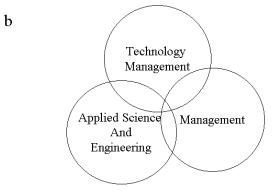|
< HOME |
MY
APPROACH TO TEACHING
|
|
Place of Management Field in
Knowledge Chain
The following two figures show the place of
management field in the knowledge chain:


Figure 1: The Knowledge Chain – two different
representations
We should note that course contents in management
departments should not be the same as in engineering departments.
There is the potential danger of introducing industrial
engineering approach into management courses especially in courses
which are in the overlapping areas, such production and operations
management.
Product or Co-Producer?
The professors' most important customer is the
student. Student does not only consume the final product
(therefore, are customers), but also participate in its production
(therefore, is co-producer or employee).
Upon a closer review, it becomes
evident that the student is not the product. The real product is
the learning of the students. Learning is a term effort between
the professor and the student. Jointly, they produce a product,
that is learning of the student. Both parties are responsible
participants in the process. Broadly speaking, it is a
multi-faceted effort on the part of all constituencies --
students, parents, alumnae, the community and the faculty.
The professor, based on his/her experience and
expertise as a producer, is the one who develops the plan for
learning, the course content. The student, as a co-producer and
customer, will focus on the teaching and learning.
Lecturer and/or
Advisor?
Learner-centered
learning substantially alters the role of a professor. A professor
is no longer a dispenser of knowledge addressed to students as
passive receptors. Instead, where small teams of students explore
and work together and help one another, a "professor" becomes a
colleague and participating learner.
Professors set directions and introduce
opportunities. Professors act as guides and resource persons, not
as authoritarian figures dictating
each step of the educational process. The relationship is
“more like being a thesis advisor than a lecturer".
Different
Approaches
We should be careful in not
overemphasizing an “Atomistic - Surface” Approach:
1. A
quantitative increase in knowledge.
2.
Memorising.
3.
Acquiring facts, skills & methods which can be retained & used as
necessary (eg at work);
4.
Awareness of task demands.
5.
New, complex & over extensive subject matter.
6.
Threat & anxiety about failing.
7.
High workload & contact hours.
8. Teacher centred
style; professor/student contact hours that are mainly didactic (ie
meant to instruct; eg lectures).
Instead, we should try to emphasize
“Holistic - Deep” Approach:
1. Understanding viz. relating parts
of the subject matter to each other & to the real world.
2. A
process of making sense of reality.
3.
Dealing with knowledge in a sophisticated relative way.
4.
Awareness of task demands.
By making presentations themselves, by
listening to presentations made by their class-mates, by
discussing the course materials in class, and by working on a
group project which combines all course material, the students get
the benefits of the holistic approach in my classes.
|